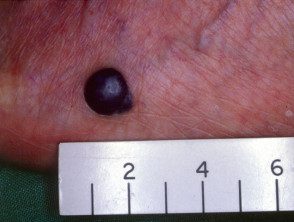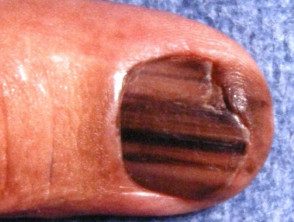Introduction
Although the main cause of melanoma is the sun, genes They are also important. Molecular genetic The study of melanoma (genomics) is rapidly increasing our understanding of the disease and how to treat it. It is a very complicated field of research. This page is a brief description of why genomics is important.
See also Genetics of melanoma.
Melanoma

Superficial spread melanoma

Nodular melanoma

Subungual melanoma
Genes are damaged by UVR
Exposure to UV radiation, particularly UVA rays (long wave Ultraviolet radiation) causes changes in our melanocyte (pigment cellular) genes.
There are likely many other triggers to explain the rare forms of melanoma that are not related to sun exposure.
Genetics and chromosomal changes may include:
- Mutations
- Duplications
- Deletions
Genetic changes can cause melanocyte cells to:
- Self destruction
- Growing up in a harmless mole
- Divide quickly, from control
- Invades the surrounding tissue
- It spreads through the blood system or lymphatic
- Induce more blood vessels grow to feed melanoma
- Prevent an immune response to melanoma.
There are numerous different genetic alterations in primary and secondary melanoma.
Driver mutations
The common driver or initiator mutations are described below. Understanding driver mutations is leading to new treatments for advanced melanoma.
- Mutant BRAF is at approximately 50% melanomas, especially those diagnosed in people under 55 years of age. It is also found in numerous harmless moles. BRAF stops the growth of moles by inducing senescence (old age) and growth arrest in the melanocytes.
- Mutations in NRAS are found in the 20% of melanomas.
- C-KIT abnormalities are reported in some melanomas arising on the soles of the feet, under the nail and in mucous membranes
- GNAQ and GNA11 mutations are associated with melanoma in the eye.
- Driver mutations are not found in approximately one third of melanomas.
Genes explain family melanoma
Some families are said to have familial melanoma, which is due to gene mutations that are passed down from parents to children and may be clinically associated atypical naevi and pathologically dysplastic naevi. Melanoma caused by inherited genes is suspected if two or more first-degree relatives (father, brother, sister, or son) are diagnosed with melanoma.
Several specific mutations have been described in different melanoma families. Around 40% has mutations in CDKN2A gene. Affected members of families with this abnormality tend to have many large moles.
Genes explain skin color.
The color of the skin depends in part on the activity of melanocortin 1 receiver (MC1R) gen.
- People with higher MC1R activity have black / brown eumelanin and easily tan when exposed to UVR.
- People with minimal MC1R activity have red hair and fair skin, due to the red / yellow pigment of pheomelanin.
- Pheomelanin blocks UVR poorly compared to eumelanin, so people with red hair and fair skin are at the highest risk of developing melanoma.
The interferon regulatory factor 4 gene is also a melanoma susceptibility gene associated with fair skin and freckles.

